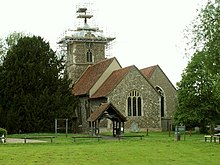St Peter's Church, Roydon
| St Peter's Church, Roydon | |
|---|---|
 |
|
| 51°46′22.07″N 0°2′16.23″E / 51.7727972°N 0.0378417°ECoordinates: 51°46′22.07″N 0°2′16.23″E / 51.7727972°N 0.0378417°E | |
| Denomination | Church of England |
| Website | St Peter's Church |
| History | |
| Dedication | Saint Peter |
| Architecture | |
| Functional status | Parish church |
| Heritage designation | Grade I |
| Designated | 20 February 1967 |
| Architectural type | Church |
| Administration | |
| Parish | Roydon |
| Deanery | Harlow |
| Archdeaconry | Harlow |
| Diocese | Chelmsford |
| Province | Canterbury |
| Clergy | |
| Vicar(s) | Rev'd Dr. Anthea Cannell |
St Peter's Church is a Church of England parish church in the village of Roydon in Essex, England.
It is not known when the first church was built in Roydon, but there was certainly a priest here in 1198 named William, as there is a document of that date bearing his name. It is probable that there was an Anglo-Saxon church, probably made of wood, similar to Greensted Church. After the Norman Conquest Roydon developed rapidly, because it was good farmland. There were four manors in Roydon: Roydon Hall where Ducketts Mead is now, Temple Hall on the site of Temple Farm, Doune (now Downe) Hall at the bottom of Low Hill Lane, and Nether Hall nearby.
In the 1200s Roydon was the most important of the local villages and held a weekly market, plus an Annual Fair on 1 August. This is the feast day of the dedication of the church to "St. Peter-ad-Vincula" (St. Peter in Chains), celebrating the day on which St. Peter was released by an angel from his chains in the prison in Ephesus. Roydon was an unusual parish, divided between the Hundreds of Waltham and Harlow (one of only five parishes nationally so divided), and being uncommonly large, with a total area of 3,031 acres.
The nave of the present church, just a simple rectangle, was built sometime between 1225 and 1240, according to the dating of the roof timbers by the eminent historian of timber buildings, Cecil J. Hewett. Initially in 1240 there was possibly a semicircular apse at the east end to house the sanctuary and the altar, but no evidence remains of this. The church contained a stone font, used for baptisms. That font has survived up to the present day, and is now sited by the north door. The font’s stonework includes the heads of the four apostles, Matthew, Mark, Luke and John. The mason had no idea of what the apostles looked like, so he used his fellow villagers as models. Two similar heads, clearly by the same mason, are outside the south door to the church, and have been there since the church was built; that is how we know that the present day font is the original. To build St Peter’s Church would clearly have needed money. This probably came from Sir Walter Fitzgerald, the Lord of the Manor of Roydon at that time, to whom the manors of Roydon Hall and Temple Hall were given in 1290. Sir Walter was one of the crusading Knights Templar, after which the Crusader public house and Temple Farm are named. The order was proscribed early in the next century throughout Europe, including in this country, because the Kings felt that the Templars were becoming too powerful. Many eminent Templars were put to death and their properties confiscated. In Roydon, their properties (including the church) passed into the hands of the Knights of St. John of Jerusalem.
...
Wikipedia
